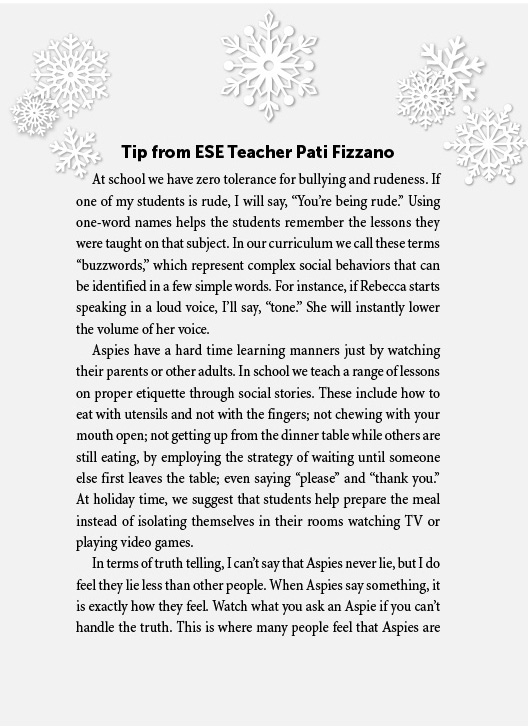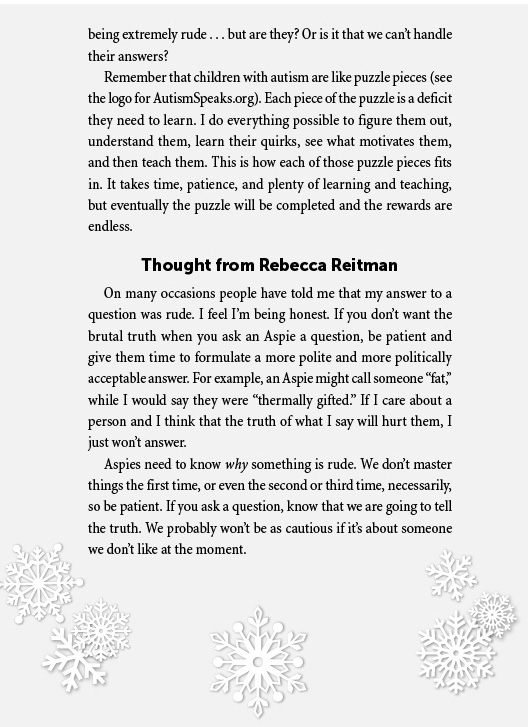
6 Rudeness, Truth Telling, and Manners
You can be strong
and true to yourself without
being loud and rude.
—Paula Radcliffe, English long-distance runner
Helpful Hint: Aspies must learn that rudeness is unacceptable, and that being rude will incur consequences. They may need an explanation of why their act was rude.
Principle: Deliberate rudeness on the part of the Aspie is unacceptable. Yet accuse an Aspie of being rude and her first line of defense will be, “But I was just telling the truth.” I thought of this when I saw the movie August: Osage County. Whenever Violet Weston, portrayed by Meryl Streep, said something mean-spirited and was called on it, she’d say, “I’m just truth telling. Some people are antagonized by the truth.” The Aspie must be shown how the truth can be told kindly and politely, without rudeness. Also, Aspies must understand that they must have good manners and acceptable behavior, even if they perceive that their personal space is being invaded, or if their extreme territoriality of property is accidentally violated.
People often don’t want to hear the truth, particularly at an inopportune time. A thin line separates the rudeness of telling a truth that inadvertently hurts another’s feelings from pure rudeness. Nevertheless, hurting another’s feelings by telling the truth and speaking in a nasty tone, as well as saying unpleasant things, are both examples of rude behavior, and neither one is acceptable. But Aspies are prone to engaging in the truth-telling type of rudeness.
Let me give you an example. In the after-school program at the middle school where they work, Rebecca and Pati tutor a fifth grader named Tony. When they assigned Tony to write about the most important person or thing to him, Tony chose his computer. Pati tried to persuade him that his mother, who was fighting cancer, might be a more appropriate subject. But Tony maintained that his computer was more important to him than his mom.
Pati winked at Rebecca and, presuming her to be an ally, asked what she thought Tony should do. But Rebecca fell back on her own Aspie trait of telling the truth (which, in this case, she did not consider rude) and took Tony’s side.
Tony’s choice of subject matter got back to his mother, who was understandably hurt. Pati explained to her that she couldn’t make Tony write what he didn’t feel. To Tony (and many Aspies), the computer is more important than a parent—it’s always there, it never yells at him, and he can communicate with it more easily than with his parents, without all the stress. It’s the truth, and the truth hurts, especially to an Aspie’s parent. Tony’s choice of a subject was typically Aspie.
Rebecca doesn’t always take Tony’s side. She often gets frustrated with him and vice versa. She wants to teach kids who want to learn and loses patience trying to help those who don’t seem to care about that. Tony, like many fifth graders, wants to play after school, and this is where the two of them don’t see eye to eye. Recently, Tony began another after-school program that involves physical activity. When Tony’s mother—who works at our school—asked Rebecca, “Do you miss Tony?” she very honestly replied, “No, the classroom is much quieter and I can focus more on tutoring the students who want to learn.” Of course, this is not what Tony’s mother wanted to hear—she loves her child with all her heart and wants to hear good things about him, as all mothers want to hear about their children. Rebecca was not being rude—simply honest—and although a neurotypical might have thought the same thing, she might have said it a different way to soften the blow.
The next example illustrates the second type of rudeness: nastiness approaching full-blown aggression. Many Aspies are territorial about their personal possessions, and some react violently to another person touching them.
Joey, a full-grown Aspie, was flying home from college, accompanied by his mother. The flight was full, as was the shelf for carry-on luggage. Joey was trying to squeeze his overflowing backpack into the overhead compartment. A female flight attendant approached Joey, smiled, said, “Here, let me do that for you,” and took the bag from Joey.
A neurotypical would have said, “Thank you.” But the flight attendant’s offer of assistance triggered rage in Joey, who thought he was under attack. He yanked the attendant’s hand from his bag and yelled, “Don’t touch my backpack!” His outburst alarmed the passengers and made the air marshals and flight crew suspect that the backpack might contain a bomb. Fortunately, his mother was able to defuse the situation before Joey got tackled or taken off the plane.
During the flight, she explained to Joey why his actions were not socially acceptable and how he might handle the situation if it came up again. When they got home, Joey and his mother revisited what happened and engaged in role-playing to teach Joey conflict resolution.
ACTION PLAN: Aspies must understand that others cannot see their “disability”—there’s no prosthetic limb or wheelchair to identify their disorder to strangers. The other person won’t realize that they’re dealing with someone who may react quite differently from what they expect.
The Aspie must be taught that there are times when telling the truth is rude and that they need to be polite in their verbal and written communications. Just because they want something, they don’t have the right to be rude about it. They need to be patient with others, in the same way that neurotypicals who don’t understand certain things about Aspies must be patient with them. If an Aspie is rude, make sure she understands exactly why what she did or said was rude (you may have to dissect the action or statement into understandable segments) and that the next time it happens there will be consequences. Rudeness can do more than make them disliked or alienate those who want to help them. Rudeness can get them beat up, suspended or expelled from school, or even arrested. There must be zero tolerance for rudeness, rage, and temper tantrums.
Training the Aspie to behave by society’s rules is a challenge for everyone who plays a part in the Aspie circle: the parent, the caring third party, and the Aspies themselves. The Aspie circle is an important tool and will be discussed in further detail throughout the book.


